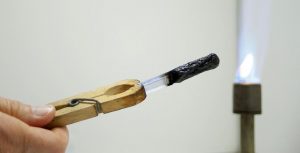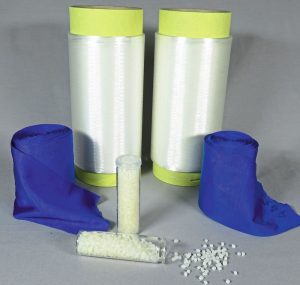The Institute for Plastics Technology (IKT) at the University of Stuttgart and the Institute for Textile Chemistry and Chemical Fibres Denkendorf (ITCF) jointly carried out research on flame-retardant polyamides for textile and plastics technology as part of a joint industrial research project (AiF-iGF).

It has now been succeeded in synthesizing an intrinsically flame-retardant polyamide which contains the flame-retardant component chemically bound in the polymer chain.
This new manufacturing process combines high flame retardancy with improved physical and physiological properties of textiles.
Dr. Georgios Mourgas, scientific assistant at the DITF Denkendorf, is in charge of this project and explains the advantages:
“Usually, large amounts of flame-retardant phosphorus compounds are added to the polymers as additives in order to achieve a good fire protection effect. And this usually happens at the expense of the physical and physiological properties of the textiles. In addition, these phosphorus compounds added in large quantities as additives prevent the necessary long molecular chains from forming and thus act as chain breakers. The resulting plastic cannot be processed into fibres at all or only with great difficulty, and due to aging and washing processes the additive emerges from the fibre over time.

With the new process, only small amounts of phosphorus compounds are required to achieve comparably good flame retardancy.
The compounds are chemically coupled to the molecular chains and thus bonded to the polymer much more firmly than would be possible with additive admixtures.
These polyamides are called intrinsically flame retardant.
This means that the flame retardant is built directly into the polyamide. This enables us to achieve a permanent, long-lasting “flame retardant effect”.
Laboratory tests have already shown that flame retardancy is just as good as that of polyamides to which additives have been added. In addition, the chemical bonding of the flame retardants to the polymers prevents migration and leaching from the fibers due to ageing, as is observed with the use of additives. Not only does the flame retardancy remain completely intact, physiological skin compatibility is also improved: Intrinsically flame-retardant polyamides release virtually no phosphorus compounds.
Skin compatibility tests rate this type of polyamide as good.
In their application, textiles made from our intrinsically flame-retardant polyamides show their advantages especially where high flame-retardant requirements are placed on the materials,” Dr. Mourgas describes the practical use of the new polymers.
“This is particularly the case for home textiles with carpets, upholstery and seat covers or curtains. However, as is so often the case with new developments, further fields of application may open up as soon as the product becomes available on the market.
